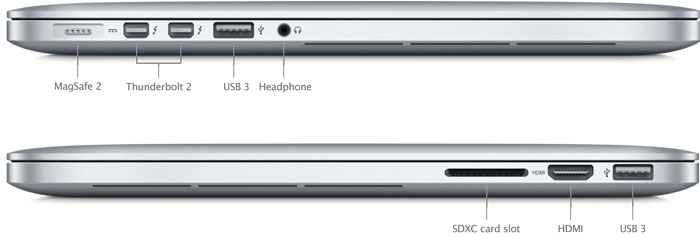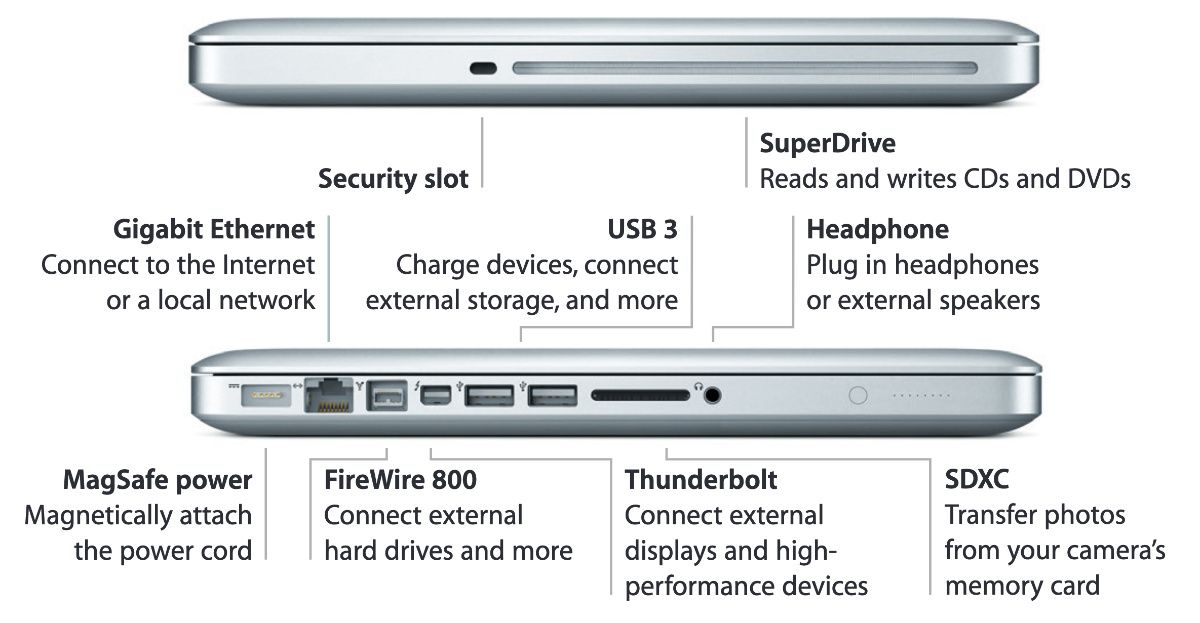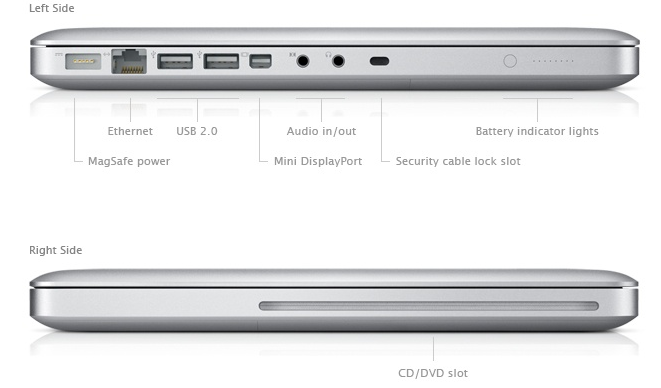If you’ve owned more than one MacBook over the years, you’ve seen how the ports on its sides have changed over time.
The number of ports has gone down considerably, but the ports themselves have become more powerful and versatile. This is clear from the kinds of accessories and external devices you can plug into Thunderbolt 3 ports versus older USB 2.0 ones.
Below, we’ve outlined what kinds of devices different ports on different MacBook generations support. Hopefully, this will show you why some ports changed and what accessories you can get for your MacBook.
MacBook Ports From 2016 and Later

You'll find these ports on the following MacBook models:
- 2016 to 2020 MacBook
- 2016 to 2020 MacBook Pro
- 2017 to 2020 MacBook Air
- 2021 M1 MacBook Pro
- 2021 M1 MacBook Air
Thunderbolt 3
Thunderbolt 3 ports are so fast you can plug in virtually anything and have it work with your Mac. Thunderbolt's USB-C shape allows for “Alternate Modes” for the port that can support HDMI, MHL, Ethernet, and DisplayPort connections, on top of general USB ones. It also allows for a Mac to be charged via Thunderbolt 3 ports.
So you can plug an external hard drive into a Thunderbolt 3 port one day, and then put an HDMI cord into the same port the next. SD cards can also be supported with adapters to fit them into the ports.
With the USB-C shape allowing for cords to be inserted in any orientation, Thunderbolt 3 ports are incredibly versatile in what can be plugged into them, and how they can be plugged in.
To access the many uses of the Thunderbolt 3 port, you will likely need several kinds of adapters or even specialized Thunderbolt 3 hubs. But at least with those and the right cords, you can use basically anything with these Macs!
3.5mm headphone jack
The only other port on these MacBook models is the 3.5mm jack, allowing for headphones to be used with a Mac. It also connects built-in microphones on headphones and earbuds as well.
You may not need this port if you prefer Bluetooth headphones, but for those who still enjoy cords, or noise-canceling features, it’s nice to see this port stick around.
MacBook Ports From 2012 to 2016

You'll find these ports on the following MacBook models:
- 2013 to 2015 MacBook
- 2013 to 2015 MacBook Pro
- 2012 to 2016 MacBook Air (this Mac doesn't have a HDMI)
Thunderbolt 2
With the same shape as the Mini DisplayPort, and supporting Mini DisplayPort video output, Thunderbolt 2 took the form factor a lot further by supporting 4K video streaming and writing 4K video to a disk while the video streamed.
For these reasons, Thunderbolt 2 is best known for connecting external monitors and cameras to a MacBook. But the port also supports external hard drives and other storage devices with faster speeds than USB, FireWire, and Thunderbolt 1 ports.
USB 3
USB 3 ports are in a USB-A shape—the traditional USB shape you’re probably familiar with. It supports a large number of computer accessories including flash drives, external hard drives, external CD/DVD players, and more.
It also allowed iPhones, iPads, and iPods to connect to a MacBook for charging and data transfer or management. It can power some small microphones and USB accessories as well.
Despite speed advantages over USB 2 and USB ports, the USB 3 port is not fast enough for connecting monitors or high-quality webcams.
With USB-A ports, the direction of cable insertion can’t be messed with—a cable must go in perfectly for the port to work. But despite this, and the speed issue, it was a major port on most MacBooks and Apple computers for a long time!
SDXC Card Slot
The SDXC card slot lets a MacBook read and write on SD cards.
A converter or adapter would need to be used for inserting miniSD cards into here. But SD cards that are typical in digital photo and film cameras pop right in and can be accessed on a MacBook the second they’re plugged in.
HDMI
HDMI ports were designed to allow computers to stream audio and visual content to external displays. This means it’s primarily used to connect MacBooks to TVs and computer monitors, but a few HDMI webcams exist as well and use this port to function.
MagSafe Power Port
The MagSafe connector was what Apple put on the ends of its MacBook chargers until USB-C charging took over. MagSafe connectors can be plugged in in any direction, and they don’t fall out thanks to the magnetism that exists between the connector and the MagSafe port.
The MagSafe port only supports Apple’s MagSafe connectors and the thinner MagSafe 2 connectors, and no other devices. But with the port on all MacBooks until 2017, you can tell it worked well for a really long time.
Other Included Ports and Notes
These MacBook models also feature a 3.5mm headphone jack.
Ports on the 2012 MacBook Pro

The 2012 MacBook Pro featured the following ports.
Thunderbolt 1
Like Thunderbolt 2, the original Thunderbolt ports replaced the older Mini DisplayPorts, and therefore mostly connected video output devices. While Thunderbolt 2 goes up to 20Gbps, Thunderbolt 1 only goes to 10Gbps, so data transfer with it is just a bit slower.
Gigabit Ethernet
The Gigabit Ethernet port allows a MacBook to connect directly to a router, modem, or wall jack to access the internet.
Using an Ethernet cable in this port, instead of Wi-Fi, can make the internet run faster on your MacBook. The port doesn’t have many uses beyond that.
FireWire 800
With faster transfer rates than a USB port, FireWire ports can connect things like high-speed external hard drives, but also camcorders and webcams.
Some cameras can connect to MacBooks via USB, and only transfer pictures along that connection. To transfer video, you may have to plug the camera into the FireWire 800 port.
So FireWire is highly utilized in film and editing, in addition to anything that needs a fast connection to work.
8x SuperDrive
The built-in CD and DVD drive in certain MacBook models allows people to watch movies and listen to music on their laptops. It also allows people to burn their own DVDs and CDs.
The inclusion of the drive made the laptop a lot heavier, and it was omitted in the 2012 MacBook Air, and most subsequent laptops, for that reason.
Kensington Lock Slot
Kensington is a company that makes locks for computers. They allow you to lock a laptop to a table leg with a cable, or lock a desktop to a desk via a locking station, making theft of the computers much more difficult.
The lock slot on MacBooks allows particular models of Kensington cable locks to be used with a MacBook without using a USB port you might need to complete your work. So it’s a port included for safety, if you have a lock of this type.
Other Included Ports
The 2012 MacBook Pro also included a MagSafe power port, two USB 3 ports, a 3.5mm headphone jack, and a SDXC card slot.
MacBook Ports From 2011

You'll find these ports on the following MacBook models:
- 2011 MacBook
- 2011 MacBook Pro
- 2011 MacBook Air (this Mac doesn't have Gigabit Ethernet, FireWire, or SDXC)
USB 2.0
In the USB-A shape most known to USB ports, the USB 2.0 ports are essentially the same as USB 3 ports—just slower. USB 2.0 ports work with speeds of 480Mb/s while USB 3 connections can get up to 5Gb/s.
USB 2.0 ports still have a ton of widely varied accessories that can be plugged into them, including keyboards, mice, and headsets. But for faster connections, you’ll need the FireWire port on the 2011 MacBook Pro, or a MacBook with USB 3 ports.
Audio In Jack
Right beside the 3.5mm audio out jack, the audio in jack existed on many MacBook models to allow microphones to be plugged in and heard by the computer.
Eventually, this port became unnecessary, as the 3.5mm jack was able to allow for simultaneous audio in and audio out. But on these earlier MacBook models, you’ll need to plug a microphone into this port with a 3.5mm cable to use it.
Other Included Ports
These MacBook models also include MagSafe, Gigabit Ethernet, FireWire 800, Thunderbolt 1, 3.5mm headphone jack, SDXC card slot, and Kensington lock slot.
*The 2011 MacBook Air only didn’t include the Gigabit Ethernet, FireWire, and SDXC ports/slots.
MacBook Ports From 2009 to 2010

You'll find these ports on the following MacBook models:
- 2009 to 2010 MacBook
- 2009 to 2010 MacBook Pro
Mini DisplayPort
The Mini DisplayPort allows a computer to be connected to a TV or computer monitor with a Mini DisplayPort cable.
The Mini DisplayPort on the 2010 MacBook Pro could also support audio transfer, like an HDMI port. Mini DisplayPorts in 2009 would require USB, FireWire, or audio line cables to be utilized for this function.
SD Card Slot
Despite the name difference with the SDXC card slot, the SD card slot isn’t really different. It can read and write on SDXC cards as well as SD and SDHC ones.
Apple doesn’t report any speed or transfer differences between the SD and SDXC card slot, so the distinction seems to be in name only. The name difference is enough for us to list this one separately, but its use is the same as the SDXC port we discussed above.
Other Included Ports
These MacBook models also include MagSafe, Gigabit Ethernet, FireWire 800, two USB 2.0 ports, 3.5mm audio out, audio in, and Kensington lock slots.
MacBook Ports From 2006 to 2008

You'll find these ports on the following MacBook models:
- 2006 to 2008 MacBook
- 2006 to 2008 MacBook Pro
Mini-DVI
Like Mini DisplayPort, HDMI, and Thunderbolt to come, the Mini-DVI port on early MacBook Pro models allowed external displays to be connected. It existed as an alternative to the Mini-VGA and allowed MacBook models of this time to be thinner due to its smaller size.
FireWire 400
Just like FireWire 800, a FireWire 400 port allows for faster data transfers than USB ports. FireWire 400 works at a speed of 400Mb/s though, while FireWire 800 is twice as fast at 800Mb/s.
FireWire 400 accessories still include cameras and high-speed external hard drives. The FireWire 800 equivalents are just a bit more powerful overall.
Other Included Ports
These MacBook models also include Gigabit Ethernet, USB 2.0 ports, 3.5mm audio out, audio in, and Kensington lock slots.
Lots of Ports, Lots of Connections
The evolution of ports on MacBook computers showcases the history and development of computers over time. What once took many ports now only takes one or two. Features that were once essential have become obsolete thanks to advancements elsewhere.
We hope our guide to MacBook ports will help you understand your MacBook model better, and what accessories you can get for it. We find the changes between the MacBook models fascinating, and hopefully it was interesting for you too!
0 Comments